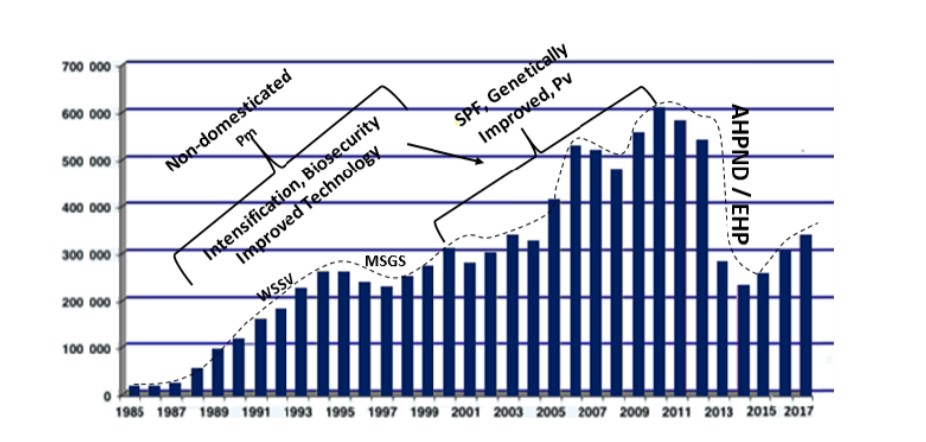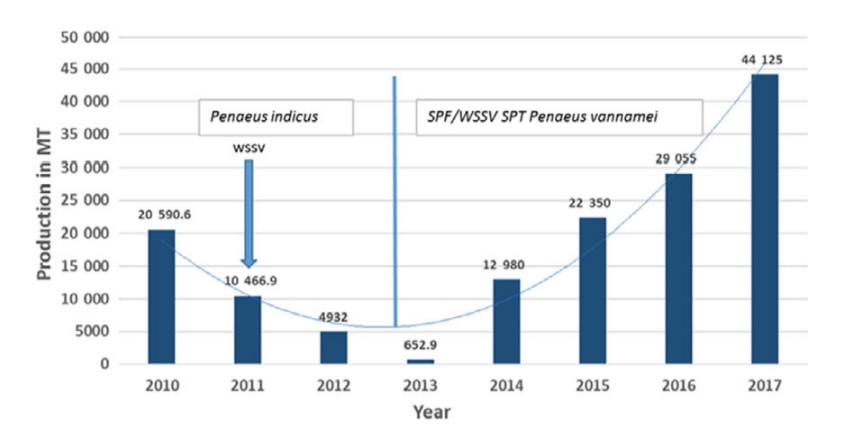Importance of pathogen detection and monitoring
Sensitive and specific diagnostic tests are an essential component to infectious disease prevention, management and control. Prior to and through the 1980’s, shrimp pathogen detection relied upon physical changes detected using gross appearance, wet-mount microscopy, histopathology and culture/identification of microbial agents that had the capacity to grow independently on formulated culture media. Except for culture and isolation on artificial media, which worked well for bacterial and fungal pathogens of shrimp, there were no cell culture systems available at the time (as well as now) applicable for shrimp virus diagnostics. Alongside the progress in development of domesticated SPF shrimp (P. vannamei) in the US under the USMSFP programme, there was a rapid evolution and advancement of diagnostic testing methodologies and specifically, rapid diagnostic tests that relied on detection of nucleic acid sequences specific for each pathogen. For the first time, in 1995, OIE published a list of penaeid shrimp pathogens, and recommended methods and procedures for testing and detecting them, in the OIE Aquatic Animal Code and Manual (Anonymous, 2001a,b) and they have since been continually updated (Anonymous, 2017, 2018).
Validation and maintenance of SPF status
Validation and maintenance of the SPF status for shrimp is a time consuming and expensive process. It requires that the facility, the biosecurity standard operating procedures (SOPs) and the shrimp within the facility conform to standards suitable for the location of the facility to ensure that the shrimp housed in the facility can be maintained as SPF (Lotz 1994). Stated differently, the validation is for the facility as well as for a specific lot or group of shrimp. For an SPF facility sited in a coastal zone, the difficulty and risk is high for pathogen contamination from operations and/ or effluents from neighbouring shrimp maturation facilities, hatcheries and/or farms engaged in non-SPF shrimp production. In contrast, the risk of exogenous pathogen contamination is reduced considerably for an SPF facility located in the same region but inland, away from the coastal zone and utilising recirculation technology with appropriate biosecurity practices.
Periodic shrimp tissue sample collection, submission and testing using the appropriate, diagnostic methods must be used (Lightner 2011; Anonymous, 2018) (where these apply) and must be based on scientifically sound sample collection sizes. Knowledge of new shrimp stock entries into the facility must be taken into consideration as well as the primary and secondary quarantine steps, processes and protocols applied prior to entry into the SPF facility. Professional, certified and licensed staff and/or recognised government or third party diagnostic laboratories should be engaged to carry out the sampling, chain of custody, laboratory assays and reporting of results. Currently, the estimated standard duration for SPF facility testing is 2 years (Lightner 2011 and OIE, 2018), unless the SPF facility was stocked with SPF founder shrimp that were an offspring generation derived from an existing population of SPF shrimp that had previously passed through the quarantine and generational testing processes. Under these circumstances, 6 months to 1 year may be an acceptable standard.
Validation of SPF quality for the OIE-listed pathogens is well established. However, emerging pathogens should also be included in the screening process as soon as these are identified. A discriminating client of SPF shrimp should exercise caution, request further testing not only for OIElisted pathogens and consider employing a quarantine phase upon arrival in the importing country where additional PCR testing, histopathology examination, microbial culture and, perhaps, bioassay challenge protocols can be conducted as precautionary steps to reduce risk and to protect themselves. This additional layer of risk mitigation is optional but in some circumstances appropriate for facilities that house high-value shrimp stocks, domesticated over many generations and genetically improved such that losing the SPF status of their herd would have devastating economic consequences for their company
Problems confirming SPF status
Although internationally approved procedures are in place to detect most of the important pathogens of shrimp that should be included in an SPF program, the issue of endogenous viral elements (EVEs)3 has become a scientific challenge for confirming and certifying the SPF status of a shrimp stock. Although many EVE originate from retroviuses, non-retroviral EVE was first reported in shrimp (Tang & Lightner 2006) for two EVEs of IHHNV. However, at the time, the term EVE did not exist and was not coined until the discovery of previously unknown and unexpected, non-retroviral EVE in vertebrates (Katzourakis & Gifford 2010). The vertebrate discovery greatly increased interest in EVE in the general scientific community. Subsequently, many more EVE for IHHNV were reported for P. monodon and P. vannamei and many of them gave false-positive PCR test results for IHHNV using the OIE recommended detection method, even though the shrimp were not infected with IHHNV (Saksmerprome et al. 2011; Brock et al. 2013). Such false-positive test results for an infectious virus could have serious international trade implications for shrimp breeders. In addition, a population or family of shrimp that has tested negative for infectious with IHHNV using the recommended OIE method may generate occasional offspring that suddenly appear as ‘pop-up’ false positives (PUPs) via genetic recombination between EVE that carry incomplete but complementary fragments of the target sequence for the OIE method. As with IHHNV, EVEs for WSSV were also found in P. monodon where they also occurred in a random manner with respect to type and number in each individual shrimp tested (Utari et al. 2017).
The relatively common occurrence of EVE in shrimp (Flegel 2009) and other crustaceans (Theze et al. 2014) cannot be disputed, and this can lead to problems in obtaining false-positive test results for infectious viruses. This could lead to restriction in the international trade of SPF shrimp stocks, limiting their supply to shrimp farmers. It is possible to eliminate the problem of false-positive test results that arise from EVE by developing an international, mutual agreement on a fixed, standard target region for each shrimp viral pathogen. The agreement process could be arranged and managed by FAO/OIE at coordinated meetings with shrimp breeding companies and shrimp farmer associations. This would allow SPF stock developers to eliminate EVE for the agreed target region from their breeding stocks. After such an agreement, any subsequent positive test result for that target region from a breeding stock would indicate the presence of the infectious virus while continual negative test results for that target region would indicate absence of the infectious virus in a stock, even if that stock gave a positive PCR test result for a different target gene sequence from the same virus.
Importance and benefits of SPF shrimp
Naturally derived SPF P. vannamei from Hawaii were first introduced (imported) to Thailand in 2002 (Wyban 2007; Lightner 2011). Following this introduction, shrimp production was revolutionised in Asia (mainly in Southeast Asia), with P. vannamei almost completely replacing P. monodon in regional shrimp production within a decade. In 2003, Charoen Pokphand Foods (CPF) in Thailand started their SPF breeding programme with high biosecurity protocols. This programme contributed significantly to exponential growth of the industry in Southeast Asia for nearly a decade, until a new disease, acute hepatopancreatic necrosis disease (AHPND) emerged in 2009. This new pathogen escaped the biosecurity measures previously implemented for viral pathogens (Fig. 1). Similarly, dramatic recovery from a national epidemic of white spot disease (WSD) was achieved in Saudi Arabia (Fig. 2), including a rapid increase in production, after the introduction of a cleansed SPF stock that was also SPT/SPR for WSD (Alday-Sanz 2018). In this case, certain biosecurity measures adapted to the local farming conditions (mostly 10 ha ponds) were implemented such as viral exclusion up to postlarvae stocking and water filtration in the ponds which ranged from 250 to 1000 microns.
Figure 1 Thai shrimp production, the impact of diseases and the influence of non-domesticated and SPF stocks

Figure 2 Recovery of the shrimp production in the Kingdom of Saudi Arabia after Penaeus indicus was wiped out by WSSV and SPF+WSSV/SPT
Penaeus vannamei was introduced. Source: Saudi Aquaculture Society.
The relevance that SPF stocks have had for shrimp farming varies greatly with region and farming practices, but it has clearly moved the industry forward in several ways. These include the following. They have reduced the introduction of pathogens and disease expression in farms leading to an immediate and exponential increase in culture performance as seen in the Figure 2. They have provided a means for safe introduction of P. vannamei shrimp around the world until it became the species of choice and the dominant one farmed. They have provided an important platform for the application of selective genetics by removing the variability of pathogen infection from individual to individual and generation to generation. Growth is a good example where the SPF approach has resulted in 15% improvement per generation, while programs that have used an SSU approach have had difficulty in obtaining growth improvements of 3–5% per generation (R. McIntosh, personal communication). Finally, the availability of SPF shrimp has been a very important asset for use as test animals in disease challenge, nutritional, physiological and biochemical studies performed in the laboratory or at the pilot scale, where minimisation of non-controlled variables is an important aspect to the study design.
Conclusions
SPF refers to the health status of a shrimp stock while SPR and SPT statuses refer to defined genetic characteristics of stocks in response to pathogens and disease. SPF lists for particular shrimp species may include pathogens that do not affect it, or affect it little but may be carried by it and be transmissible to other disease-susceptible shrimp species. The objective is to avoid negative impacts on production, transmission among species and trade barriers that might arise from pathogen detection in shrimp and shrimp products. The designation ‘USS stock’ alone gives no indication of either the specific health status or specific genetic characteristics of a shrimp stock with respect to pathogen and disease response. However, USS stocks may be suitable for conversion to SPF stocks using screening to select individual animals free from a specific list of pathogens for two consecutive years. It is also possible to combine strategies such as SPF+SPR, SPF+SPT or SPF+SPR+SPT in order to help shrimp farmers prevent disease outbreaks in grow-out ponds. The success of these approaches may depend on the biosecurity strategy defined for each facility. Farmers must also consider other aspects of stock performance such as growth, survival, etc. that may be related to stock health status and genetic status. We recommend that farmers cooperate with one another in critical evaluation of stocks provided by commercial suppliers. This can be done by simple epidemiological techniques to determine the relationship between their stock sources and stock performance including such things as disease response, growth, survival, etc. Over time, this analytical process should reveal the identity of the most reliable stock suppliers with respect to overall stock performance.
By: Victoria Alday-Sanz, James Brock, Timothy W. Flegel, Robins McIntosh, Melba Bondad-Reantaso, Marcela Salazar và Rohana Subasinghe
“Domesticated Shrimp Postlarvae – The Key To Success”
See more:
- Microalgae Boosts Water Quality And Finishing Yield In Whiteleg Shrimp
- International Artemia Aquaculture Consortium Plans To Launch This Year
- Age Has The Biggest Impact On Gut Microbiota Diversity In Black Tiger Prawns, Not Protein Sources

 Tiếng Việt
Tiếng Việt 中文 (中国)
中文 (中国)